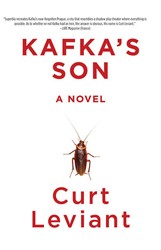 Elie Lichtenstein recently spoke with Matthue Roth about his newest book, The Gobblings.
Elie Lichtenstein recently spoke with Matthue Roth about his newest book, The Gobblings.
Elie Lichtschein: You’ve written both novels and picture books. Does the process of writing a picture book differ much from writing a novel? How so?
Matthue Roth:The process of writing any story is different than any other one, of course — just by virtue of the character and the plot and the lives you’re telling. But yes. When you’re writing a picture book, you’re making a blueprint. Every line you write is going to linger in the artist’s mind and is going to be magnified a thousand times — you only get, what? Five or ten lines to a page? And partly because the artist will transform those five or ten lines into a whole tableau. Multiply that by sixteen double-page spreads, and that’s the space you get to tell an entire story.
EL: What did the collaboration process between you and Rohan look like?
MR: There’s a period of time where the manuscript is fully mine, and then a period where it’s fully his. Our editor, Robert, is sort of the in-betweener — he’s the conductor. There was some back-and-forthing, which was annoying for Rohan, I’m sure, because he was already working on layouts when I was still planning what would happen in the big chase scene. But it also made everything a lot more integrated; it made the whole book more of a collaborative effort.
EL: What was the impetus behind The Gobblings? What inspired and pushed you to write it?
MR: Mostly this intense feeling of loneliness I had while spending time in Australia, and a Baal Shem Tov story of a boy on his own in a synagogue in a strange town on Yom Kippur [see the review here for a summary of the story]. I want to say that my kids pushed me, too — and they do; they’re always asking for stories, and my head is rarely together enough to be able to launch a story at them fully-formed — but I think at heart, every story I tell is for myself. If it doesn’t hold my attention, picture book or novel or film or something else, then it’s probably not good enough for anyone else to read.
EL: What other works inform your writing? Which authors — classic or contemporary — were most influential while you worked on The Gobblings?
MR: I think there’s a lot of Kafka in there. And some of Maurice Sendak, who’s basically in my DNA, and Kelly Link, who tells these very natural and organic science fiction stories that are both comforting and scary.
EL: You’ve written a picture book retelling classic Kafka stories. And the gobblings — long-snouted, reptilian, alien monsters who feed on metals and machines — are wonderfully Kafkaesque in their mundane absurdity; they are, essentially, huge mosquito-like pests in outer space. Was this a conscious choice to channel Kafka in their creation?
MR: It really wasn’t a conscious choice to evoke Kafka, although he’s always hunting around my brain. One reviewer pointed out that nobody’s really evil in The Gobblings; even the gobblings only do what they need to to survive. It’s really like a fairy tale — well, with space ships and robots and stuff. Nobody’s wicked; they just have different priorities.
EL: I understand you recently received an MFA in creative writing. Did The Gobblings, in an earlier draft, make an appearance in your program?
MR: Not directly! But I think telling stories is one of those things that, the more you do, the better you get. It ramped up my skills, not just how to tell “Adult Literary Fiction Short Stories,” but how to tell stories.
EL: To write a picture book, do you need to be transported back into your childhood? Or else into a wide-eyed, all-is-possible, child-like mindset? If so, how do you achieve this?
MR: I think that telling any story is like creating a world. Sometimes it’s even literal. I think I definitely get transported into a different mindset, but it’s less “a kid mindset” than it is the mindset of my character. I think it’s really just, like, whose story am I telling, and what words and form tell it best? And for Herbie, I was like, this is a picture book.
 EL: What can readers expect from you next?
EL: What can readers expect from you next?
MR: I have two picture books in the works! One is called No Dogs Allowed, and it’s about a dog that gets kicked out of a corner store and goes on a sort of fantastic undersea journey. The other is We Are in a Pot of Chicken Soup, and it also has a sort of fantastic journey. Under, um, schmaltz.
EL: What are you reading right now?
MR: A short novel by Steve Stern, The North of God, part of Melville House’s wonderful novella series. And I just got my press copy of this crazy anthology called Jews Vs. Aliens, which I’m in, but now is the first time I get to read the other people’s stories, which are uniformly bizarre and awesome. And with my kids, we just watched the film Labyrinth for the first time, and we’re rereading Maurice Sendak’s Outside Over There, which it’s based on.
Elie Lichtschein is a writer and musician based in New York. He is currently pursuing an MFA degree in Creative Writing from the New School, where he is completing a mysti-fantasy Middle Grade adventure novel.
Related Content:
- Reading List: Matthue Roth
- Reading Matthue Roth’s blog posts for the Visiting Scribe here
- Reading List: Recent Children’s/YA Reviews



